Introduction
The hospitality industry is one of the fastest growing industries in the world. According to Chevalier and Mazzalovo (2012), the number of hotels in Europe has registered consistent growth over the past five decades. These European hotels are currently facing stiff competition from others in North America, Asia-Pacific, Middle East, and parts of Africa. Grenier (2017) says that in the tourism sector, hotels play a critical role in defining the number of regular visitors that a country receives. Besides the beautiful sceneries and other points of attraction that a country may have, the quality of service that clients get in the hotels also define the ability of them to be attracted to a given country.
They prefer having high quality service in the hospitality sector after spending time in the field with nature or other man-made sceneries. For business executives visiting a country for a short period to make business deals, the main factor that defines their choice of hotel is the nature of service that they get. In Europe, the city of Paris in France has always been considered the top tourists destination. In fact, Robinson-Tomsett (2013), says that Paris is still the world’s top tourists destination center despite the rapid growth of other cities such as Dubai in the United Arab Emirates. The competition in the hospitality sector is expected to get stiffer than it was before and companies in this sector are struggling to find ways of remaining afloat. The hotels have been struggling to maintain a strong brand image in the market to help them create a pool of loyal customers. It explains why luxury hotels have been keen on creating unique identity in the market.
The identity that a company creates in the minds of its customers is very important in the current competitive business environment. Customers often have several options to make whenever they want to purchase a product in the market. The growing size of the hospitality industry means that customers are constantly presented with several options from which they can choose. According to Chevalier and Mazzalovo (2012), creating customer loyalty is very critical in the hospitality sector. Luxury hotels are coming up with various approaches of creating identity in the market. Traditionally, companies relied on their brand name, brand image, brand colors, and other brand attributes to promote their identity in the market.
However, that is no longer the case in the current competitive business environment. A trend is emerging where luxury hotels are moving away from the reliance on their brand name and image to define their identity. Grenier (2017) says that hotels are now focusing more on the products they offer to promote their identity in the market. They have come to the realization that they need to create an impression in the minds of their customers about the superiority of their products in the market. Although brand name and logo may strengthen their hotel’s popularity in the market, it does not bring out the image of the superior products such a hotel offers. They have realized that they need to ensure that whenever a name of their hotel is mentioned, customers will have a clear image of the value it offers in the market. Luxury hotels have taken the lead in using their product portfolio to promote awareness and identity of their brand. In this paper, the researcher seeks to investigate the extent to which the identity of luxury hotels rely on refined table arts.
Discussion
Understanding the Concept of Identity
It is important to start by understanding the concept of identity, and importance in the hospitality industry. Understanding this concept will help in explaining why luxury hotels have given it a special focus in their operations. According to Craig (2013), identity refers to a fact of being what a thing is. It is what makes a given thing unique among the rest. Olmedo (2015) says that it is what is used to identify something from the rest. Companies, just like people, need their own identity that helps in setting them apart from others within the same industry. Traditionally, companies have been using names to help in defining their identity in the market. In the hospitality industry, brand names such as Hilton, Sheraton, and InterContinental have been dominant over the past several decades. Companies realized that using name is not enough.
It is easy for people to remember a simple name such as Hilton. However, some business owners realized that the name of their businesses could not be properly pronounced or understood by foreigners, especially if the name is in a language that they do not understand. For example, a name of a business written in Mandarin language cannot be easily read by people who do not understand the language. In fact, Grenier (2017) says that for non-Chinese speakers, Chinese words almost appear the same. They appear more as drawings than words that have meaning. If a firm relies on such a name to define its identity in the global market, then it may be impossible to achieve the desired goal. As globalization continued to be relevant, companies tried to translate their names into popular languages. A good example is shown in the figure below:

As shown in the figure above, this Chinese company realized that it could no longer rely on the Chinese market. It needed to expand in its market operations to continue with its growth. However, it could no longer rely on the Chinese name that it had been using in the local market. It had to find a name that was universal in the global market. It has to translate its name from the Chinese language to English, and the name became Brilliance Auto. In fact, the new name has become more preferable in the firms local operations in China than its original name. The act of translating a company’s name from one language to another is important, but it is not an effective way of defining a firm’s identity. Various reasons justify the ineffectiveness of using the strategy to identity a company in the market. A Chinese company operating in Europe may be forced to translate the name from Chinese to English, French, German, Spanish, and many other European languages used in various countries in the region. It is not possible to provide such a long list for identifying a company in the market. Any such attempt may only confuse customers, something that it counterproductive for a firm seeking to promote its identity. It meant that companies had to shift from translation of names to something that is more effective. That is when the use of brand logo emerged.
Companies realized that instead of struggling to come up with several translated names for their products, it was easier and more effective to use a brand logo that would not need translation. The use of an image instead of a word was an easier way of creating memories in the minds of the customers. Even if they struggle remembering the names, the image would help them in identifying the company that offers the products they prefer. Branding then became a very popular concept in the business arena. According to Grenier (2017), branding is currently one of the most important areas in marketing, that companies are now making heavy investment. In fact, Olmedo (2015) notes that it has reached a level where brands are assigned monetary values based on how popular they are in the market. Apple Inc., Coca Cola, and General Electric are some of the brands that have become very valuable in the market today. They have been heavily promoted in the market and associated with high value or popular products. The figure below shows some of the top brands in the world.
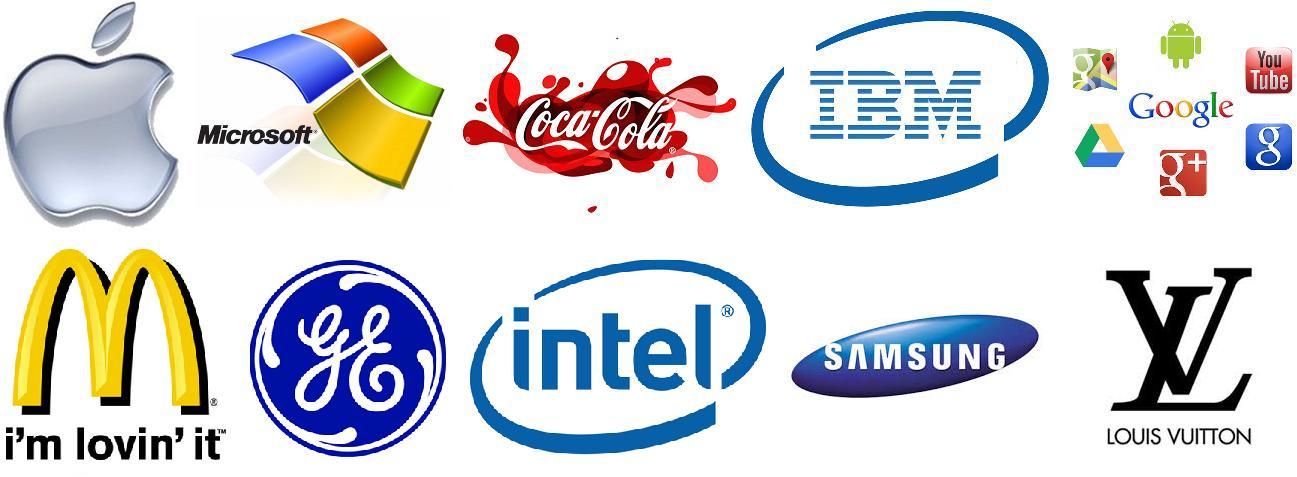
As shown in the figure above, some of these top brands no longer consider brand name as an integral part of their brand identity in the market. They are moving away from words and getting into the world of images. Olmedo (2015) says that images tend to be more memorable than words, and that is why it is becoming increasingly important when it comes to identifying products. For instance, Apple Inc, which is one of the most valuable brands in the world, is not using its name in its brand logo. However, people have come to associate that image with the brand that they no longer need to see the words ‘Apple Inc’ to identify its image. All the products of this company bear that image and customers knows its meaning. The same trend is seen at McDonald’s brand image. Just using the letter ‘M’ with that unique shape is enough to make customers identify the brand among the rest. General Electric has used artistry to spell GE as a flower and to create other supportive images in its brand logo. The use of image is increasingly becoming important in defining the identity of companies in the market.
In the hospitality industry, the trend is gaining popularity rapidly as hotels try to define their identity as uniquely as possible. From a general perspective, one can argue that products offered in the hospitality industry are very similar. All that a guest needs is a decent place to sleep, clean up, eat, and relax as he or she tries to undertake other activities that made it relevant to check into a hotel. However, Grenier (2017) says that hotels have been working hard to differentiate their products in the market to attract more customers. These hotels offer the above basic needs that any visitor would require. However, they are moving a step further in improving the experience. The above services are offered in a unique manner that makes customers feel they are special. They ensure that any service offered provides the best value possible to their customers. Some hotels spend millions of dollars annually as they try to offer additional value to their customers. It is important for these firms to ensure that they get maximum value from their additional investment made towards improving the value of their products. That can only be achieved by ensuring that their products can easily be identified in the market. That is why they are currently using various approaches of promoting their identity in the market. The following image shows some of the top brands in the hospitality industry.
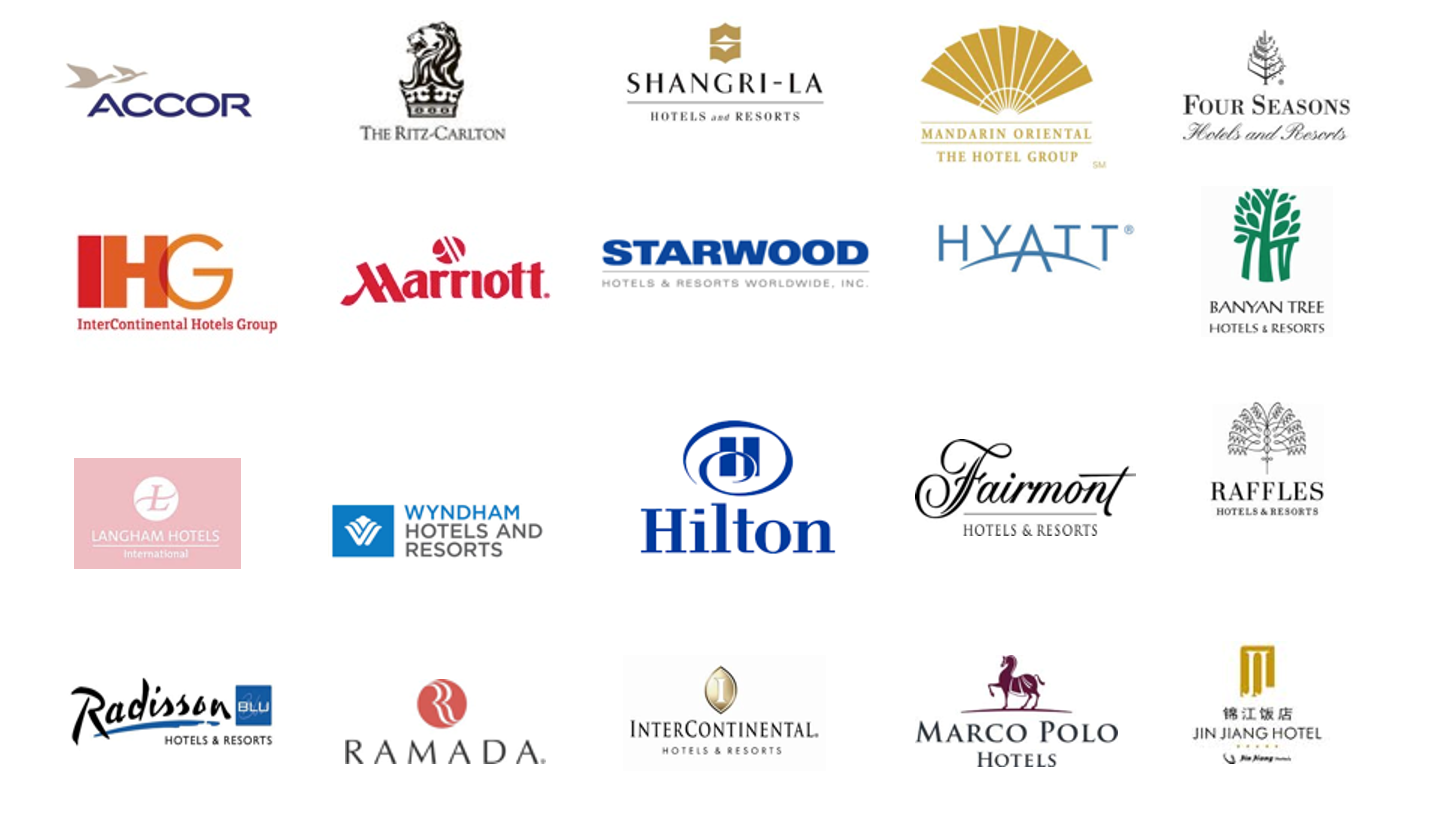
Identity of Luxury Hotels
According to Penner et al. (2013), luxury hotels, as the name suggests, offer high-end hospitality products and often target the rich. In market, segmentation is one of the most important tasks of marketing managers. It is important to understand the customer needs based on their social status. As Craig (2013) says, in every street of major cities there are hotels offering basic needs that a traveler may need. Then there are the high-end hotels that only the rich can afford to visit. These luxury hotels have specialized on serving people of high social standards. Olmedo (2015) observes that although the rich may not be very sensitive to the high price that these hotels may charge, they are very keen on the quality.
Any simple detail that is ignored when serving them may lead to serious dissatisfaction. Their habit is very different from that of the poor who can compromise quality for the sake of getting the best price in the market. The rich are also very particular in what they want from a hotel. Their menu is so specific even if they are miles away from their home country. They would want the specific foods they always eat while they are at home. The materials of their beddings must also be very specific because of their sensitive skin based on the lavish lifestyle they are used to back at home. Everything in their room must be specific, from lighting, to table arrangement, spacing, water, and much more. Meeting such unique needs is not easy. Sometimes it forces these firms to hire employees of different nationalities. It is common to find a luxurious hotel in Paris hiring employees from the Middle East, East Europe, North America, Asia-Pacific, and Africa. They understand that the best way of meeting the diversified needs of their customers from all over the world is to have a diversified workforce.
A cook and a waiter from Saudi Arabia are best positioned to understand the kind of meals and the manner in which a client from the same country would want to be served. Having such a diversified workforce means that such high-end hotels spend a lot in the remuneration of their employees. Other than the workforce, there is also the investment needed in the structures and systems in such hotels. Robinson-Tomsett (2013) says that these customers do not settle for less because they are willing and able to pay very high prices. They want the best in every service that they are offered. That includes the best security within these premises. These hotels must not only offer security to their lives and lives of their loved ones, but also their property and privacy. Some of them are prominent people who are keen on avoiding the constant pressure from members of press who may want to know various issues from them. They want assurance from these hotels that if necessary their presence in such luxurious hotels will remain as confidential as possible. Meeting these needs forces these hotels to invest in state-of-the-art technologies in communication, security and other areas when providing them with the needed service. Most of these luxurious hotels in major global cities such as Paris, London, New York, Dubai, and Tokyo have been able to meet these needs. It is important for them that after creating such a perfect environment needed by their very demanding clients, they are able to develop a pool of loyal customers. They want to ensure that these customers not only make repeat visits, but also recommend their friends and family to such hotels. That can only happen if they develop a proper identity in the market.
Identity of the luxury hotels has become more important than it ever was before in the hospitality industry. These hotels want to ensure that their superior services remain memorable in the minds of their customers. Exceeding the expectations of their customers is one of the ways of doing that, but they also need a strong identity that makes them stand out in the market. They need to ensure that their name is associated with specific services that they offer. Craig (2013) says that luxury hotels are under great pressure to associate themselves and their brand with a specific set of customers. The identity needs to help them achieve that desired association. According to Chevalier and Mazzalovo (2012), brand name and logo was traditionally used to identify hotels in the market. That is how leading global hotels such as Hilton and InterContinental hotels were able to popularize their products in the market.
However, Robinson-Tomsett (2013) warns that the strategy of using brand name and brand logo is becoming less popular among luxurious hotels in terms of defining their identity in the market. Indeed the brand name and logo is still in use as the official identification of these top hotels. However, when reaching out to their target customers, the logo and name of a brand is not actively used. Top hotels are moving towards a completely new trend that was not common in the past. They are now using images of the services they provide to define their identity in the market. Some of them are using the images of the beds and bedrooms of their hotels. Others are using the beautiful views of their outdoor facilities such as Olympic-size swimming pool and golf courses. Others are using the images of their refined table arts as a means of promoting their identity. Each of them try to use something that they feel most of the customers they target are looking for whenever they visit a given hotel. It is important to look at the extent to which the identity of luxury hotels rely on refined table arts in the current hospitality industry.
Extent to Which Identity of Luxury Hotels Rely on Refined Table Arts
It is explained in the section above that luxury hotels are under pressure to offer products that meet specific needs of its customers. People travel from one place to another for various reasons. The reason behind someone’s or a group of people’s trip to a given place defines their needs when they visit the hotels. Some travel to have fun with family while others travel for business purposes. Other than the personal needs of a client based on his or her socio-economic background, the hotels must understand that the purpose of the visit may influence the nature of products offered to the clients. Refined table arts in luxurious hotels are designed to reflect these varying needs. People with different reasons why they visit a hotel may prefer varying arrangements for the tables. Hotels have come to appreciate that sometimes the decision that influence the choice of hotel that clients make is the refined table art. They know that visitors who come for a conference will rarely check into a hotel if they are not assured of a conference hall that has the arrangement suitable for their functions. As such, refined table art is being used by these hotels as a means of identity in the market (Adlin, 2013). Instead of using their brand, they are reminding or informing their customers about what they have on offer. The trend has become so important that most hotels use refined table arts instead of brand as a means of their identity. To explain the extent to which the identity of these luxury hotels rely on refined table arts, it is necessary to look at the various customers that these luxurious hotels serve and the relevance of refined table arts to them.
The business class
Refined table arts are very critical for business executives and their teams when they are decide to take a vacation with specific goals in mind. It may be a team-building forum. In such forums, members would be expected to bond, and understand fears and concerns of one another. According to Penner et al. (2013), multinational corporations such as General Electric and Apple Inc. often take their top executives and mid-managers on business trips so that they can discuss issues that affect their departments. They also get to discuss how they can coordinate their activities to enhance the overall performance of their company. When such business trips are organized, the choice of the hotel must be made with great care. These executives will need more than just comfort and good meals. They will need a perfect environment where they can engage in small groups and conference halls where they can be addressed by the top leaders in their organizations. Luxury hotels understand how to these unique needs, and have come up with unique table arts. Figure 4 below shows such an arrangement that would be suitable for such team building forums.
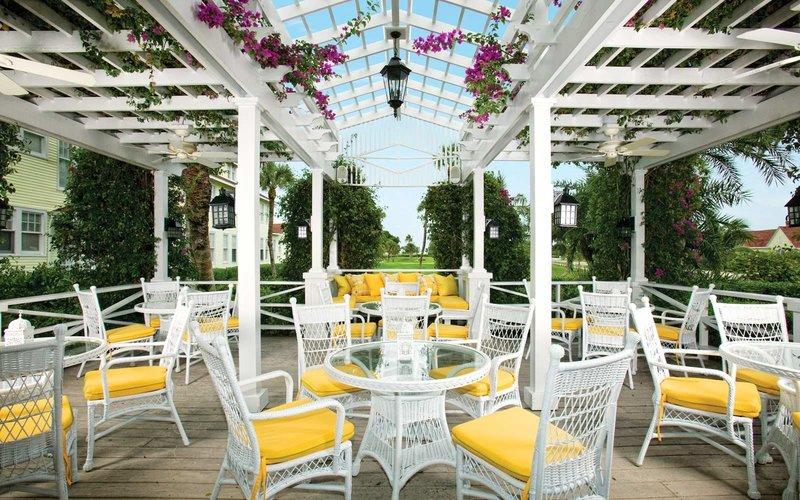
As shown in the figure above, the design and arrangement of the tables and chairs makes it easy for a larger team to form small discussion groups and share issues relevant to their organizations. The arrangement allows people to form small teams ranging from three to ten people as would be necessary. The design also shows that if necessary the design can be rearranged to accommodate larger groups. Understanding these needs, some of these top hotels are now using the refined table arts to define their identity. When one goes online to look for the appropriate hotels, instead of finding the brand logo, they would find such images to emphasize on the hotel’s ability to meet their needs.
The individual traveler at work
The nature of work of some people forces them to leave their homes and travel to various parts of the world to undertake specific assignments. Journalists offer a perfect example of such people. They may travel to many places to report on various happenings around the world. When these individuals are looking for a hotel, they often prefer tables that can enable them do their job. In fact, they are looking for an alternative office away from home. The rooms that they need must facilitate them in meeting the desired goal. For such a visitor, even if other services in a hotel are perfect, their priority will be their workstation within the assigned hotel rooms. They need a proper table and a chair that can facilitate their work. The table should be properly lit day and night. Figure 5 below shows a room that would be perfect for such an individual traveler at work. As shown in the figure, the table is set in a way that it has access to natural light by daytime. At night, a lamp provides ample light for such a visitor. At the table, the visitor can use a telephone in case he or she needs something. The design of the table and all the accessories that come with it, and the manner in which it is positioned shows that the hotel understands the needs of its clients. When a hotel is majorly targeting such customers, it may opt to use such an image to define its identity in the market. Instead of a logo, the refined table art is used to attract customers. It helps in informing them about the nature of products they should expect when they visit the facility.
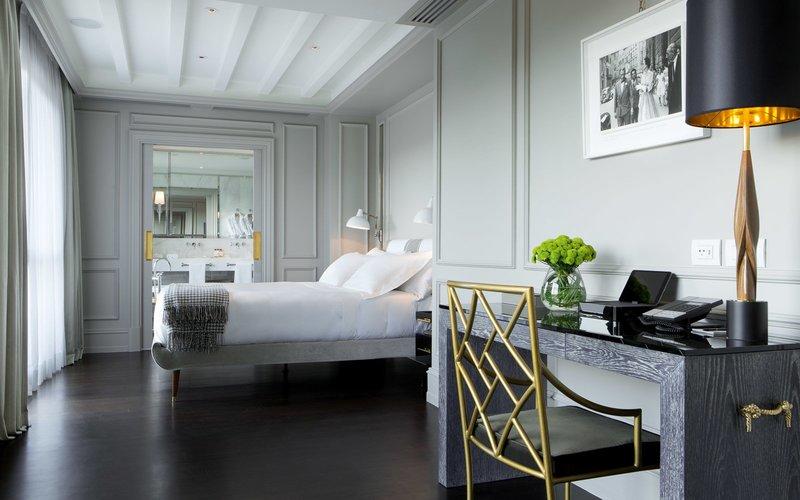
The family
Some of the top luxury hotels receive families from various parts of the world. Just like individual visitors, families can be very demanding. In fact, families are more demanding that individual visitor. As an adult, one can compromise on the quality of services that a hotel offers. However, when such a person decides to bring his or her entire family, it may not be easy to convince them to stay in a hotel room if top quality is not guaranteed. Issues such as safety and security are some of the top concerns of such visitors. Some of these royal families also prefer hotel settings close to what they have at home. Other than the bed and other outdoor services, families highly value the table setting. At mealtime, such a parent would want to have the entire family sitting together. It helps in strengthening the family bond. Figure 6 below shows a perfect table design for a family. With both parents at the extreme ends of the table, they can easily monitor their children as they have their meals. Such a setting also makes it easy for such families to have a roundtable discussion before or after their meals. It is possible for a hotel to use such an image when promoting its brand in the market other than using its brand images. That is so because it is such an image that the hotel would prefer their customers to have in their minds, reflecting the actual service that they should expect when they visit.
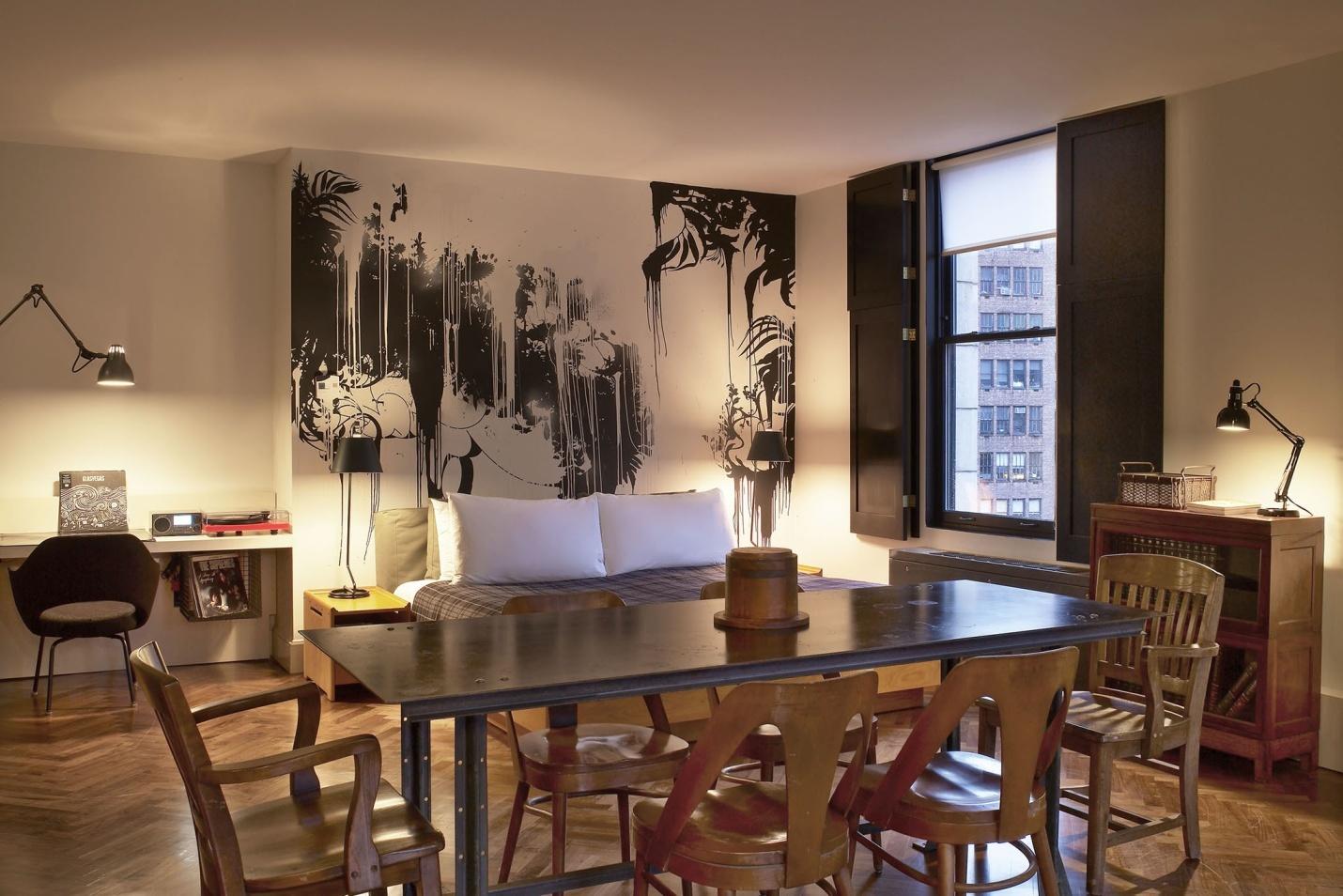
The honeymooners
According to Olmedo (2015), the honeymooners form another critical market segment that is often targeted by luxury hotels. It is important to note that honeymooners are not necessarily people who have just had their wedding. It might be a husband and a wife or any other similar arrangement of people who just want to spend quality time as a couple. It is important to emphasize that these people are keen on having fun and being close to each other. The arrangement of the hotel room they would prefer should be suitable for two people. Figure 7 below should such a possible arrangement. During mealtime, the couple can move to the table and have their meals while discussing issues relevant to their visit to the place. After the meal, relax on the couch, on the other end of the table. They also have entertainment system that they can control while at the table. Such refined table arts may be used by a hotel that primarily targets honeymooners.
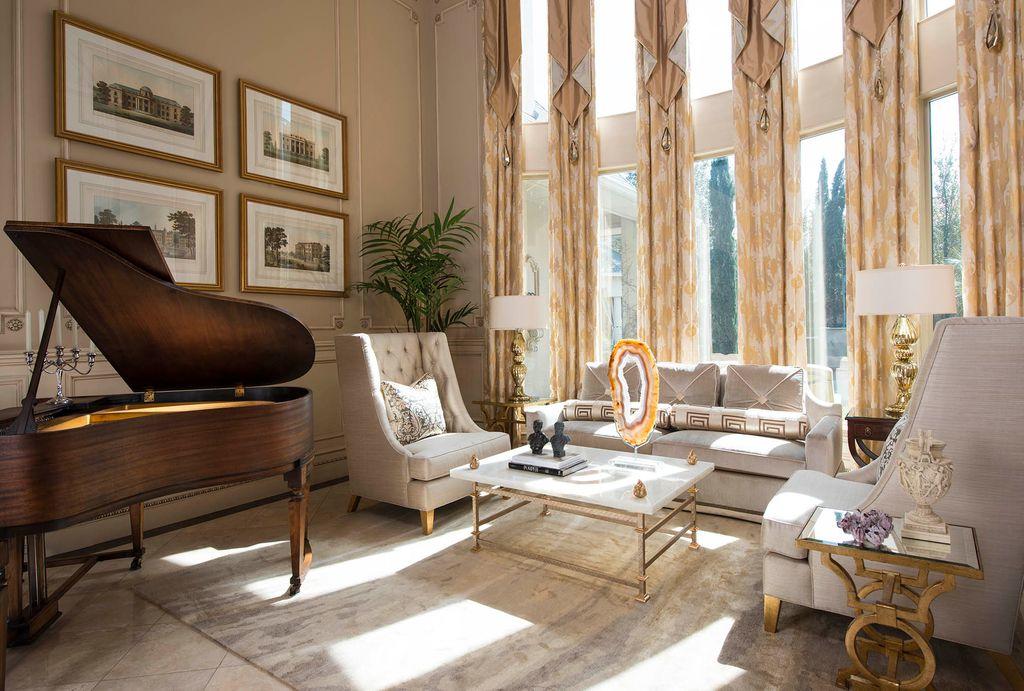
The cultural client
According to Robinson-Tomsett (2013), some of the luxury travelers love their culture so much that they find it so hard behaving differently even when on a safari. Some of the leading hotels have learned how to take care of the unique needs of such customers. In this context, it is important to note that their culture may be based on the kind of food they eat, the kind of people they want to serve them, and the arrangement of seats. For instance, when the royal families from United Arab Emirates, Saudi Arabia, or such families travel out of the country, they often prefer staying in hotels that reflect their way of life back at home. Figure 8 below shows an arrangement of tables and chairs at one of the luxury hotels in New York designed for such families.

According to Chevalier and Mazzalovo (2012), many luxury hotels around the world are now embracing the new concept of refined table arts as a means of identifying their brands. Competition is getting stiff and customers are constantly exposed to many brands that it is difficult for them to know the right choices to make. High-end customers purchasing products offered by these luxury hotels know specifically what they need. However, knowing where they can get the best value may not be easy in an environment full of information, some of which are misleading. That is why top hotels are moving from the system of using brand image to a system where they embrace a strategy of showing what they offer. Using refined table arts, customers are fully informed about the products to expect instead of just knowing about the logo of the firm. Adlin (2013) says that when one visits online trip advisors to look for hotels where they can visit, it is uncommon to find brand image of these hotels in the photos provided online. Almost all of the top hotels use images of their hotels, especially the interior and outdoor facilities meant for the visitors. Refined table arts are some of the images that they use to inform customers about what they should expect from the hotels. The identity of these luxury hotels heavily rely on refined table arts and such related images to help attract clients.
Arguments Against the Use of Refined Table Arts for Identity of Luxury Hotels
According to Kapferer et al. (2012), not everyone agrees with the emerging trend where luxury hotels use refined table arts to promote the identity of their brand and to attract customers in the market. Some have argued against the trend, and one of their main bases of their argument is that it kills branding in the market. The brand name and brand logo of products in the market is very critical for the survival of a firm. Companies are spending millions of dollars annually to promote their brand name and image knowing that these are critical ingredients of success. In the hospitality industry, leading multinational hotels such as InterContinental and Hilton heavily promoted their brand name and image in the market. They are still some of the most valued hotel brands in the market although they have not gotten into competition of using refined table arts to promote their products. They believe that with strong brands in the market, it is possible to attract customers. With a brand name that is respected in the hospitality industry, a hotel would not need to resort to using images of their products to attract customers. Customers love the brand, and even if they have not used it before, they would always want to try it.
Craig (2013) says that the new trend may not be sustainable in the near future. In fact, it may be counterproductive. That is so because in a market where competition is so stiff, dubious businesspersons are always looking for ways of defrauding customers in the market. Counterfeiting is currently one of the biggest problems that firms have to deal with in the market. When a luxury hotel with a high reputation uses an image of its products to promote itself in the market, it is easy for other smaller companies to create similar settings at their facilities and use the same trend to promote themselves. It means that when a customer goes online to look for the appropriate hotel to visit, he or she will be subjected to a scenario where all the images are more or less the same. In such a situation, a firm cannot take advantage of its strong brand name.
It is easy for such a confused customer to visit an alternative hotel because of the difference in pricing, hoping that the services offered at these hotels, based on the images presented are the same. A top hotel with high quality products will lose customers, not because of the poor quality services it offers, but because clients in the market are confused. Brand name and logo provides a perfect platform for a hotel to differentiate itself from its rivals in the market. In case a different firm uses the same or related brand image or name of a given company, the affected company has the liberty of taking the offending company to court over copyright issues. Such a scrupulous company would be punished and the top brands would feel protected. However, when images of products are used instead, then it is easy for other firms to abuse copyright issues because they can create similar settings. That is why top luxury brands should not be quick in embracing the new trends.
Robinson-Tomsett (2013) feels that relying on refined table arts to promote identity of luxury hotels kills curiosity among customers. Sometimes a visitor may be influenced to visit a given hotel because of the curiosity about the products it offers. When they are only provided with the brand name and logo, and promised premium quality services, they develop curiosity about the nature of products to expect. That curiosity is a strong enough driving forces that can make them visit a hotel. However, when the customers are offered the images of the settings of these hotels, they may be quick to make judgments. They will start making comparisons with other top hotels, which have presented similar images. Craig (2013) says that it may not be possible to take photos of the entire hotel and upload them in online platforms. Only the selected few are often uploaded, either one or two. Sometimes the uploaded photo does not capture the exact need of the targeted clients. One can easily jump into conclusion that such a service is not offered at the facility. A client who was keen on having services of a swimming pool will swiftly ignore advertisements of hotels that have used images of their indoor services because that is not the area of their interest. It may not mean that the hotel that has a swimming pool as one of the images on its online advertisement is the best. The fact that others have not used the same images makes them inferior in the eye of the customer.
Conclusion
The growing economy of various countries around the world has boosted the hospitality industry over the past few decades. Many hotels are emerging in different parts of the world keen on offering unique products to its customers. The growth of the industry has been characterized by emergence of top luxury hotels and increased competition in the market. Luxury hotels are offering high-end products to their customers in unique ways. However, the stiff competition that they face in the market forces them to promote their products in unique ways. Using of brand name and brand logo remains an important strategy of promoting the image and products of a company in the market. However, it is not enough to rely on the brand name and logo to define the identity of these hotels. High-end customers are very specific when purchasing products in the market.
They know what they want and often avoid any product that they feel fails to meet their expectations. Knowing that most of these customers are always busy and lack time to visit numerous hotels before selecting the appropriate one, luxury hotels now provide customers with images of their products in their advertisements. They make it possible for these customers to experience the services before even visiting the hotels. Refined table arts have become major sources of identity for these hotels. They help the hotels explain to their customers how uniquely their needs will be met when they decide to visit. A trend that started with just a few firms has become so popular. The identity of luxury hotels heavily rely on refined table arts. However, when using this approach, hotels should not ignore the need to promote their brand name and logo.
References
Adlin, J. (2013). Vanities: Art of the dressing table. New York, NY: Metropolitan Museum of Art.
Chevalier, M., & Mazzalovo, G. (2012). Luxury brand management: A world of privilege. Hoboken, NJ: John Wiley & Sons.
Craig, B. M. (2013). Rewriting American identity in the fiction and memoirs of Isabel Allende. New York, NY: Palgrave Macmillan.
Gifford, J. (2017). The top 100 hotels in the world. Web.
Grenier, H. (2017). Tourism and identity in Scotland, 1770–1914: Creating Caledonia. London, UK: Taylor & Francis Group.
Kapferer, N., Bastien, V., & Dawsonera. (2012). The luxury strategy: Break the rules of marketing to build luxury brands. London, UK: Kogan Page.
Olmedo, E. (2015). Identity at work: Ethnicity, food & power in Malaysian hospitality industry. London, UK: Springer.
Penner, R., Adams, L., & Rutes, W. (2013). Hotel design, planning, and development. New York, NY: Routledge.
Robinson-Tomsett, E. (2013). Women, travel and identity: Journeys by rail and sea, 1870-1940. Manchester, UK: Manchester University Press.